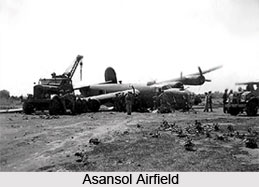 Asansol Airfield was a military airbase located in West Bengal. This airbase was established during Second World War in the year 1941 by the British Empire in India and the American Government which was combined as Allied Powers during Second World War.
Asansol Airfield was a military airbase located in West Bengal. This airbase was established during Second World War in the year 1941 by the British Empire in India and the American Government which was combined as Allied Powers during Second World War.
This airfield played a most significant role in resisting The Axis Powers, specially Japanese and the Azad Hind Fauz, led by Netaji Shubash Chandra Bose from 1943 to 1945. The Japanese conquest of Burma now Myanmar was significant for this Asansol Airfield. On April 3 in the year 1942 six USAAF 7th Bombardment Group B-17 Flying Fortress aircraft took off from Asansol Airfield to bomb warehouses and docks at Rangoon now called Yangon.
History of Asansol Airfield
On April 6th and 7th, 10 DC-3`s of Pan American Airways began hauling 30,000 gallons of fuel and 500 gallons of lubricants from Dum Dum Airport, Kolkata which is now called as Netaji Subhas Chandra Bose International Airport, Kolkata to Asansol for operations. This fuel is subsequently transferred via Dinjan Airfield, India to China, which was for use by Lieutenant Colonel James H Doolittle`s raiders when they landed in Chuchow, about 100 miles southwest of Shanghai, China after their attack on Japanese Army during the invasion of Manchuria. The Doolittle Raiders never made Chuchow due to fuel shortages and aircraft subsequently lost.
In the year 1943, Asansol airfield turned over to USAAF. Initially this Asansol Airfield, used by 5318th Provisional Air Unit, beginning late 1943 operating P-51 Mustangs, B-25 Mitchell medium bombers and C-47 transports with Waco CG-4A gliders was used for attacks in Burma (Myanmar). The unit tested the United States of America first use of a helicopter in combat, six Sikorsky R-4s in May 1944. 1st Air Commando Group activated in May 1944. Used by 164th, 165th, 166th Liaison Squadrons, equipped with UC-64, L-5 observation aircraft during September-December 1944. Later Asansol Airfield was used by 5th and 6th Fighter Squadrons, December 1944-June 1945 flying P-47 Thunderbolts. This air field of Asansol was also used by 319th Troop Carrier Squadron, flying C-47s from September to December 1944.



















